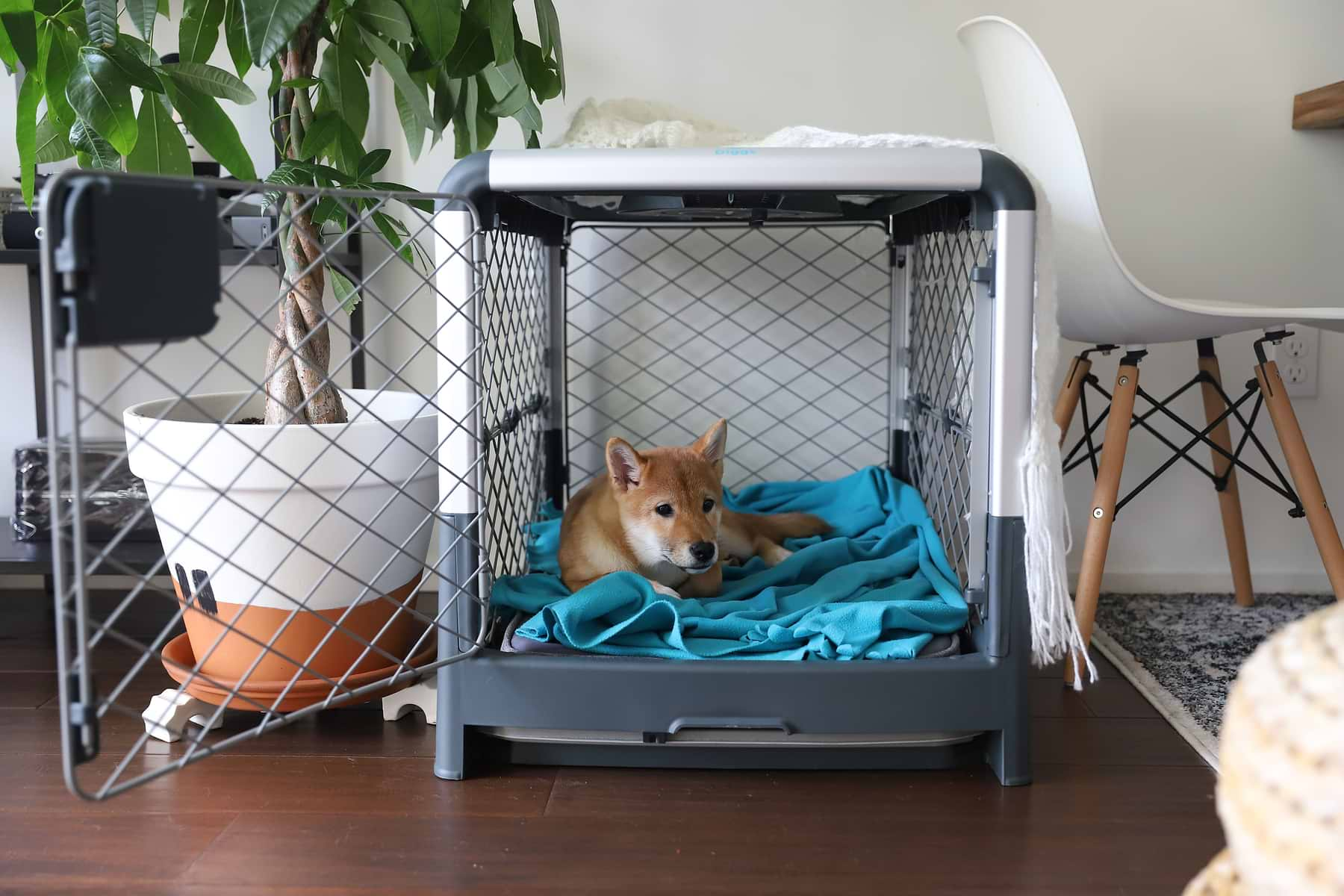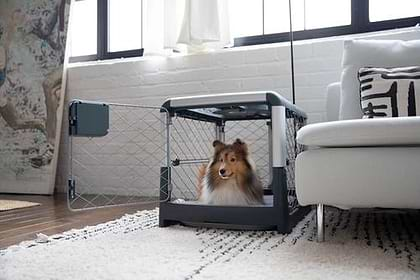
As a pet parent, do not feel guilty for introducing your pet to a crate. Crates may be enclosed spaces, but they are immensely important when introducing a pet into your family and home, regardless of the dog’s age. Why are they important? Because they provide your pet with shelter. It is a place where your pet can get away and relax.
Crate training your pet creates endless possibilities and benefits for both you and your pet. Successful training allows your pet to fully participate in your and your family’s lifestyle without the added stress.
Crates Are Safe Havens, Not Jails
Proper training and positive reinforcement encourage dogs to view crates as an area of your house where they can go for rest and relaxation. Training and building a pleasant association does take time, so be patient with your pet as they learn how to trust being inside of the crate.
Why Choose Crate Training? What Are the Benefits?
Crates are oftentimes directly associated with potty training. Yes, they certainly are useful to teach your pet that it’s best to use the bathroom outside. But their sole purpose is not for this one type of training. The benefits of crate training can be plentiful for both you and your pet in the long term when used in an enthusiastic way.
Dogs are den animals. No, they do not spend the majority of their lives within a “cave,” but they do use them. The purpose? Dens, or crates in this instance, serve as a safe, clean, protective space. They are not meant to be a prison for your pet, but a desirable destination or hideaway that they can escape to.
You may be curious as to why a pet needs this when they have a whole house or a whole yard to roam around. Well, think about it. If the weather outside is frightful, or indoors there is a lot of stimulation or the noise level is too loud, a pet will seek shelter. A quiet, dark, familiar place to go to for periods of time to calm down and recollect themselves. Everyone, including pets, need their space sometimes.
Have a rescue pet? If so, rescue pets truly benefit from crate training. Again, crates provide added comfort and security, even for adult dogs. For rescues, this is their space. Crates become a luxury for them. It is a place they can retreat to if they become fearful for any reason because of past experiences that may have been traumatic for them.
Housetraining
Pets do not want to eat nor sleep where they use the bathroom. That’s where the crate training comes into play, especially at an early age. Housetraining your pet can start at any stage of life. Puppies are the most common, but if you are getting ready to introduce a newly adopted pet into the home, you’ll still need to teach them the rules.
Upon adoption, your pet may already be potty trained. So why do accidents still happen indoors? It could be that your pet senses other pets are or were in the household. They may want to mark their territory with a potty break. Just like humans write their name on items to signify it’s theirs, dogs do the same with their urine.
Pets may also break the housetraining due to anxiety or medical concerns such as a bladder infection. If this happens, watch their behavior closely for signals of distress. Think about changes that may have taken place around the household. For instance, has there been a change in your pet’s diet? If you have continued concerns, contact your veterinarian to rule out health concerns.
Medical Conditions, Concerns, and Issues
What do crate training and your pet’s health have in common? Crate training is known to lower levels of stress and anxiety in pets. Your pet will thank you for this as they age and are at risk for arthritis, canine cognitive dysfunction, etc.
As puppies turn into adults, and adults turn into seniors, more frequent naps result. Crates are an added plus because they are a source of comfort, giving your seniors a privileged space to rest those achy joints for long periods of time.
Travel Safety
The ASPCA recommends that your pet is familiar with a crate, especially when traveling. Crates provide protection for your pet.
Travelling can relate to miles away, or down the street. You can be visiting family and friends, or taking your pet for a vet visit. Either way, using a crate is the finest option for a few reasons
- If you are behind the wheel of a vehicle, you don’t need distractions.
- If your pet is on its way to the veterinarian, they could be startled or stressed. Using their crate gives them peace of mind since they are already familiar with it.
- If you are traveling by plane, your pet can sit in the cabin with you if small enough. Otherwise, they will need to be stowed with the cargo. Flying is a stressful experience for both humans and pets, so allowing your pet to reside in a recognizable, safe place such as their crate is a plus. Remember when flying you must use a crate or carrier that is IATA (International Air Transport Association) compliant.
Regardless of the form of travel, using a crate to carry your pet with you is essential.
Choosing the Right Crate
Selecting the perfect crate for you, your dog, and your home takes a little research. Crates come in a variety of sizes, colors, materials, etc. How are you planning to use your puppy's crate? Will it be long-term or short-term? Do you have a preference as to the color of the crate, or what it is made out of? Where do you intend to set up the crate?
These are all questions you need to think about when purchasing a crate for your pet.
Size Matters
Choosing the size of your pet’s crate is an important step. The crate will be what your pet associates as a home, as a place of comfort and security. You wouldn’t like to live in a cardboard box, right? Your pet wouldn’t like to either. So how do you choose the right size crate for your pet?
To answer this question, a few more need to be asked:
1) What type of pet do you have? Is your pet a large breed or a small breed? No one wants to be squeezed into a tight space. The perfect crate allows entry from your pet and flawless movement from the front to the back of the crate. They should be able to walk in without needing to crouch down and be able to turn around with the crate door closed.
2) Is your pet a puppy or an adult? Remember that puppies don’t stay small forever. Depending on the breed or your pup, it’s possible they will outgrow a crate if you purchase it too small and don’t plan ahead accordingly. The good news is that you can purchase a crate based on your puppy’s estimated adult size and still have successful results with crate training. Look for crates that have puppy divider panels. These allow you to adjust the interior dimensions of the crate.
When are dogs considered adults versus puppies? Again, depending on the breed anywhere from one to two years old. Once labeled an adult, they should be full grown.
Make the effort to measure your pet and refer to the sizing tables associated with the crate of your choice. You will want to measure both the height (when standing) and the length of your pet. The length is measured by the tip of your pet’s nose to the base of their tail. Then most importantly, add four inches to the measurement! This serves as your guide to determining the best size crate to introduce in your home.
3) Do you plan to use the crate for the short-term or long-term? Why this question is asked is to understand your preference and plan for using a crate in the future. If it is simply to get through the stages of potty training, then you won’t have a future need for it; however, if you are planning to make the crate a permanent go-to option for your pet, then you’ll want to look at crate durability when choosing the right crate for your pet and for your home.
When considering short-term versus long-term, remember that your pet should only be confined in the crate for short periods of time, and for no more than eight hours in a day (less than three or four hours if your pet is just a pup). After crate training is complete, this should be an open space that your pet can freely enter and exit, especially when you are home.
Creating a positive crate experience for your pet begins with having it sized right. Take the time to research the best crate to place in your home for your furry friend; it matters!
Crate Materials and Types
Now that you have an idea of the size of crate you need for your pet, you can start browsing the inventory at local pet supply stores. Crates are built with different materials including fabric, metal, plastic, and wood.
What material is best to use? That is up to you. You should select an option that is durable and will last a long time. Let’s take a quick look at the different types of materials.
- Fabric crates are collapsible, flexible, and best used for smaller pets during travel.
- Metal crates are a popular choice as they are easy to clean. Most are collapsible for easy storage or relocation too. Metal crates come with an option for divider panels giving you the option to size up and allow for the crate to grow with your pet.
- Standard plastic crates have similar durability to that of metal crates, and they are lightweight like that of fabric crates. They do not typically have an option to fold.
- Wood crates are not the best option for crate training and are more so used outdoors.
Determine the type of crate you’ll want in your home based on its functionality. If you are concerned about its aesthetics, look into crate options that are fashionable and can be modeled after your furniture. It is worth it if you plan to associate the crate as a long-term home for your pet.
Additions To Help Make the Crate Desirable to Your Pet
Make this step fun and exciting for both you and your pet. This is the part where you can decorate and style, making it an enjoyable space for your pet.
Dress the crate up with a form of bedding for your pet to snuggle up in. You can use a blanket, a towel, a crate pad, etc. This could be trial and error until you find the material that your pet prefers, especially if your pet is a bed shredder.
Another option is to find food stuffed or treat release toys your pet enjoys. This helps with mental stimulation and can keep them busy for hours.
Placement of a Crate in Your Home
Finding a place in your home for a crate should be easy, right? Well, that depends. Crates can be big and bulky, particularly if your pet is of a large breed. There are also environmental factors you’ll want to consider.
Is the location of the crate near a window, or close to a heater or a fireplace? Keep this in mind as you scout out a place around your home. You don’t want your pet to be within direct sunlight, to get too cold, or risk overheating.
The location should be on the drier side versus a drafty or moist environment. Make sure that there is proper ventilation and that your pet can move around should they become uncomfortable with the temperature.
When crate training a puppy, you’ll want to place the crate in a high-traffic area in order to keep a close eye on your pet. This also gives them the feeling that they are a part of your pack, engaging them in your day-to-day activities and lifestyle. At night, you may want to keep it close by where you sleep since you will be getting up often to let them outside to use the bathroom.
As pets become older, they may prefer a quiet place in your home over a busy, noisy place. In that case, keep the crate in a location that is away from loud noises, such as in a bedroom. Remember, dogs prefer discreet, low-lit areas, similar to that of caves in the wild. They are also social animals and consider you as part of their pack.
Proper Introduction Between Your Pet and the Crate
The crate is now set up and ready for its new resident. It’s time to introduce your pet to their new home. Don’t rush the introduction of the crate to your pet and don’t use force. Force leads to a negative experience and can cause crate aversion or separation anxiety. Take the right measures and be patient with your pet.
Introducing your pet to their new crate takes time. In fact, it can take anywhere from a few hours to a few weeks to correctly associate the crate as a safe, trusted place for your pet.
When you are ready to begin introductions, ask yourself this: has the new resident been introduced to a crate in the past? If you have a puppy, the answer is most likely a no, allowing you to start the training on fresh ground. However, if your pet has had previous experience with a crate you may need to be extra careful in your planning, specifically if the prior experience was negative.
Encourage and Reward, Don’t Use Punishment
In general, training takes a lot of time and patience. Before introducing a new pet into your home, or beginning a training exercise with your current pet make sure you have a plan in place and that you will be present. Training is all about repetition and routine.
At any point during the training, you’ll need to keep yourself in check. Punishment should never be an option, only encouragement. Why? Raising your voice at your pet, or reacting in a negative way raises the stress and anxiety levels your pet endures. So instead of seeing victorious results with training, your pet may find a place to hunker down and hide. They may not provide you with the cues you need to guide them down the right path.
The Bottom Line
Dogs have a need to feel out of harm’s way and secure. After all, they are den animals. A crate takes advantage of dogs’ natural instincts, serving as a bed or a den to them. Use this to your advantage and venture down the path of crate training with your pet. Crate training gives your pet a sense of security and leads to good behavior when executed in a positive manner.
Finding the perfect place for your pet to relax has never been easier. Create a place of comfort and security with crate options at Diggs. Explore what Diggs has to offer and discover how crate training can be a fun and positive experience for you and your pup.
Sources:
Why Crate Training is Important
Crate Training Benefits: Why A Crate Is Great For You And Your Dog
Buying Guide: How to Choose the Best Dog Crate for Your Pet
Crate Training: Your Dog’s Portable Safe Haven, And How To Help Him Love It
How to Crate Train Your Dog in Nine Easy Steps – American Kennel Club

The Diggs Team
We believe our dogs deserve safer, better designed pet products.
You might also like
Crate training tips, stories and inspiration
View all blogsIn Your Diggs
Share your photos with #DiggsPet and tag us @DiggsPet on IG and TikTok.


